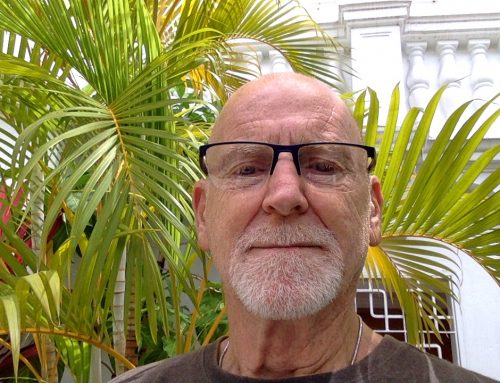July 2011
I arrived at the ER in pain like a rabid badger in my guts. Hunched over, shuffling, I had a little paint bucket in my hands because I wretched continuously. I sat in the chair across from the receptionist, my bucket between my feet, and passed her my insurance card. She said, “I’ll get you through this just as quick as I can,” and passed me a few pages, holding them still so I could sign consent to treat and privacy forms.
When I was done signing, a young man appeared with a wheelchair. He pushed me into one of the examination rooms and there, the nurses and lab techs bustled around me while I heaved unceasingly into my bucket.
Someone helped me into a gown. A tech drew vial after vial of blood. A nurse started an IV. She pushed a syringe into one of the ports and said, “Anti-nausea medicine is coming now, hon. A nice, big dose. There’s pain medicine, too, and there will be more as soon as we get some idea what’s happening.”
Someone rinsed my bucket and returned it to me, and someone brought me wet washcloths and wiped my face and my neck. I knelt, hunched, on the ER gurney and when the puking slowed, I was wheeled for a scan, and another scan, and someone said pancreatitis, a diagnosis that was not familiar to me, but my family was there so I sank low, low into my body, to deal with all that was happening in me.
“More pain medicine, hon. Lots of it this time. You can’t have anything at all to drink or eat for a few days, OK? Then you’ll have surgery. But for now, you’re going to feel better. You can go to sleep and when you wake up you’ll be in your room.”
A hospital room was exactly where I woke up, and I lay there for three days while nurses came every few hours to pump me full of opiates, anti-nausea medicine, and antibiotics while I slept on and on. The techs on the floor came and helped me to the bathroom when I rang and eased me into a chair every day so they could put clean sheets on my bed.
October 1989
I arrived on the unit with my head down and I didn’t realize where I was until I heard the noisy clunk of a steel door behind me. Someone officious sat me in a mustard-yellow plastic chair under a row of pay phones and asked me many questions, many of which had to do with the timing and sequence and timing of my symptoms.
“How is your appetite?” she asked, and “Are you sleeping?” She wanted to know, “Would you say you feel sad rarely, some of the time, most of the time, or all of the time?” Lifelong good girl that I was, I tried to answer her questions. “My appetite is fine,” I said, and “I haven’t slept in a very long time,” and, “I’m sad all the time.”
“Oh, come on, you can’t be sad all the time! Something must make you happy!” she chirped, and I cried harder, a stinging river of tears on my hot, raw face and I couldn’t answer, wouldn’t answer her. Naughty, naughty me. Bad, confused, lying me, causing all this fuss and surely there was something that made me happy.
For weeks, I had thought of nothing but death. When I closed my eyes to sleep, I saw murder and torture and it seemed as much fantasy as nightmare, so I sat up at night staring at The Donna Reed Show, Lassie, and Green Acres in endless, stupid succession while I sharpened all the knives in the house. I didn’t eat because I was lower than a worm. During the day I sped my tiny roller skate car up and down the mountain roads near my Arizona home, seatbelt unbuckled, daring myself to sail off the cliff.
Would you say you are sad rarely, sometimes, most of the time, or all the time?
I was eventually sent to the day room while the nurses looked through my luggage Once there, I cocooned myself the best I could with a hospital blanket in one of the ultra-light molded plastic chairs. My 1:1 babysitter sat next to me, dutifully lighting my succession of cigarettes while she read the newspaper.
The other patients swirled around me, interacting with their hallucinations, asking me questions, changing the channel, banging on the glass that surrounded the nurses’ station shouting, “I need more valium. More Valium, goddammit! You didn’t give me enough valium, you bitch!”
July 2011
Returned to my room after surgery, my pancreas calm and my gallbladder gone, I was allowed ice chips, then water, and finally a little food. I felt dreadful, the cumulative effects of the original illness plus several days of near-total immobility and huge doses of opiates to ease the pain of a pancreas that was actually digesting itself.
My guts were so full of fluid that when I was removed from supplemental oxygen, my blood saturation levels plummeted to potentially fatal levels, so I had to stay in the hospital longer than expected. I wanted to go home the way a newborn pup wants to be close to its mama, so I rang the tech every two hours all day and night. She hustled to my bedside, helped me sit up, put my slippers on my feet, and switched me over to the portable oxygen tank from the outlet on the wall. She dragged that oxygen tank behind us 5, then 10, and finally 15 minutes as I slowly walked the halls to hasten the removal of all the fluid that was preventing me from breathing.
October 1989
Late on my second night on the unit, the charge nurse motioned me to come outside with her. She lit my cigarette, then lit one of her own and asked me, “I hear you want to die. Why would you want to die? You’re young and pretty and you have everything going for you.”
I shrugged.
“Well,” she said, “you know that we can’t really help you, right? I mean, if a person really and truly wants to die, there’s not much we can do to stop them.”
May 2014
When I think of stigma, the first thing that comes to my mind is not misrepresentation in the media or criticism from friends and family, but my experiences of accessing mental health care for myself and my children.
Stigma is in the mustard-yellow ugliness of psychiatric hospitals. It’s in the peeling paint and the torn seat cushions.
Stigma is in the long waits, patients “boarded” in emergency rooms while other patients with illnesses of similar severity are moved quickly to inpatient beds as I was when I had pancreatitis.
Stigma is in the impatience of psychiatric staff. It’s in the system that leaves them too overwhelmed with work to care about individual patients, and undereducated about the nature of mental illness.
Stigma is in restrictive visiting hours when a patient is receiving psychiatric treatment. Stigma is in insurance company’s refusal to pay for adequate treatment, and in the system’s hyper-application of privacy laws for psychiatric care compared to all other kinds of medical care. But most of all, stigma is in our cultural unwillingness to take mental illness seriously before it’s a crisis.
Our health care system is a reflection of this cultural reality: we deny treatment, or make treatment so difficult to access that we may as well be denying it, until there is a crisis. How much kinder, to treat mental illness the way my pancreatitis was treated. How much more humane, to greet a mentally ill person when she or he seeks care the same way my son was greeted when he presented with a broken elbow.
How much suffering could we prevent?
Adrienne Jones lives in Albuquerque, NM with her Deadhead husband, their outrageously cool kids, and Doodle the Wonder Pug. You can find her vacillating between radical idealism and self-righteous anger at No Points for Style and find links to other things she does on the internet at about.me/AdrienneJones.








Leave A Comment